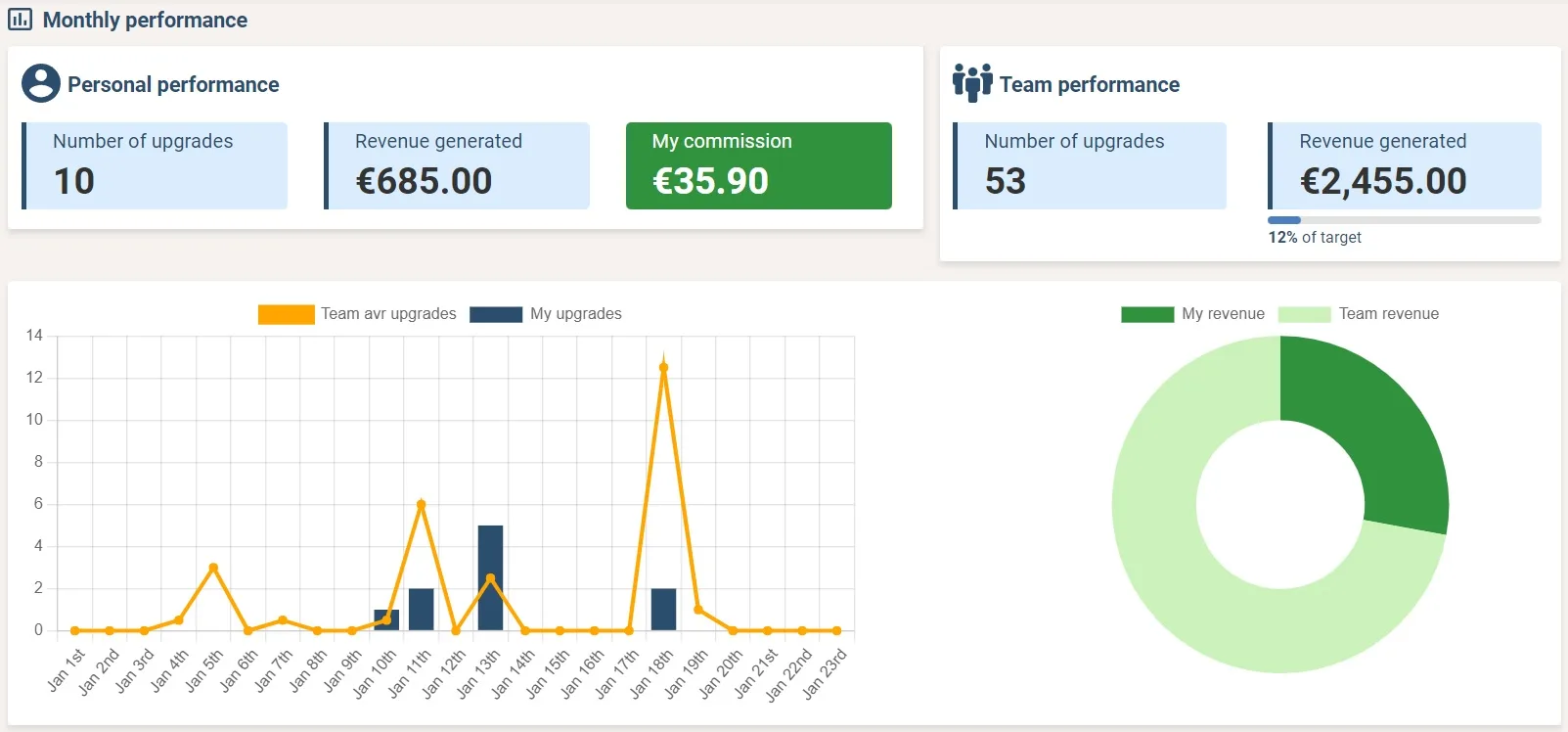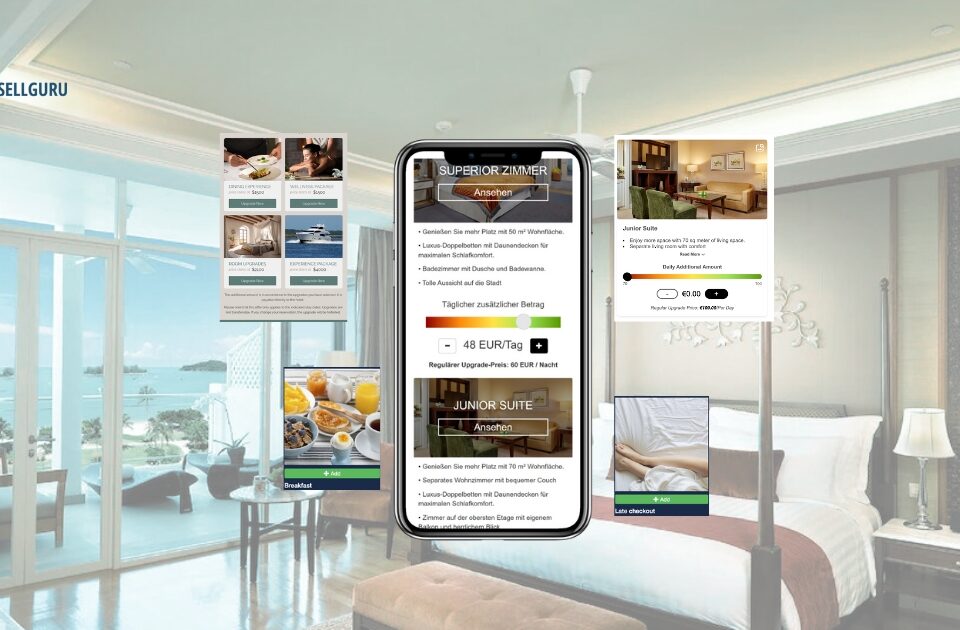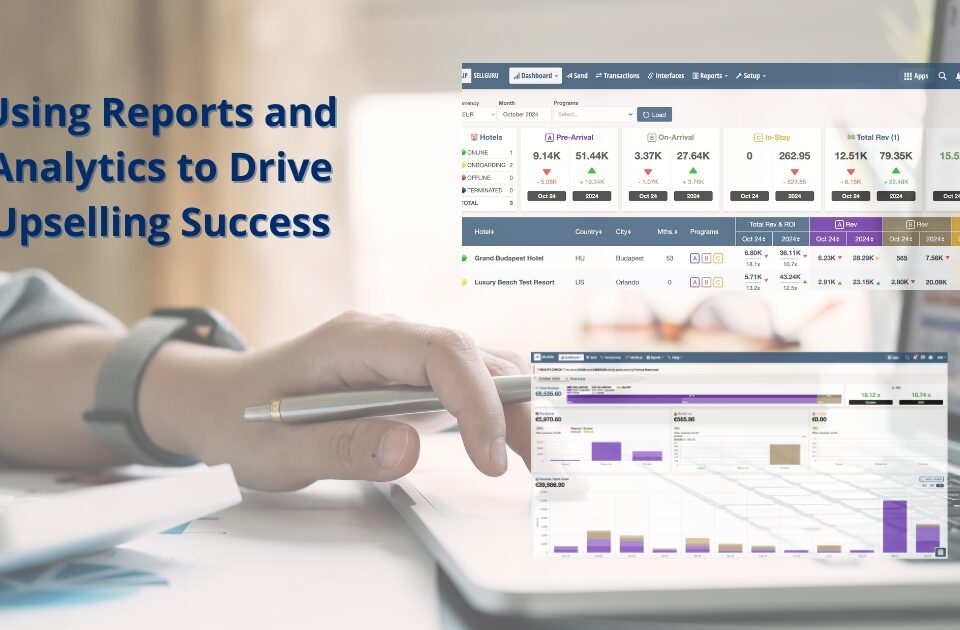Measuring the success of hotel upselling strategies

The upselling guide book | Download
February 21, 2023
UpsellGuru x Avalon Cloud Integration Partnership Announcement
February 27, 2023As the hospitality industry becomes increasingly competitive, hotels are constantly looking for new ways to drive revenue and improve the guest experience. One of the most effective tactics for achieving both of these goals is upselling, which involves offering guests additional products or services beyond their initial booking.
But how can hotels determine whether their upselling strategies are actually working? In this article, we'll explore some key metrics and strategies for measuring the success of upselling in the hospitality industry.
Track conversion rates
Conversion rate is a critical metric for measuring the success of upselling strategies because it provides insight into the effectiveness of different upsell offers. Essentially, conversion rate measures the percentage of guests who take advantage of an upsell offer, relative to the total number of guests who were offered the upsell.
For example, if a hotel offers an upgrade to a premium room to 100 guests and 20 of them accept the offer, the conversion rate would be 20%. By tracking conversion rates for different upsell offers, hotels can identify which offers are most effective at driving revenue and providing value to guests.
Tracking conversion rates can also help hotels to identify patterns in guest behavior and preferences. For example, if the conversion rate for room upgrades is consistently higher on weekends, this could suggest that guests are more willing to pay for a premium experience when they are on vacation or celebrating a special occasion.
By analyzing conversion rates, hotels can adjust their upsell offerings to better align with guest preferences and behavior. For example, if a certain upsell offer is consistently underperforming, the hotel may want to adjust the price or reposition the offer to make it more attractive to guests.
Measure incremental revenue
Incremental revenue is a crucial metric for measuring the success of upselling strategies because it directly relates to the financial impact of those strategies on the hotel's bottom line. Incremental revenue refers to the additional revenue generated by upselling, over and above the revenue that would have been generated without upselling.
For example, if a hotel generates $100,000 in revenue over a certain period, and $20,000 of that revenue is generated through upselling, the incremental revenue would be $20,000. By measuring incremental revenue, hotels can determine whether their upselling strategies are having a meaningful impact on revenue and profitability.
One advantage of focusing on incremental revenue as a metric is that it allows hotels to evaluate the overall impact of their upselling strategies, taking into account the costs associated with upselling. For example, if a hotel invests in training staff to upsell effectively or in developing new upsell offerings, these costs can be factored into the analysis to provide a more accurate assessment of the return on investment for these initiatives.
By tracking incremental revenue, hotels can also gain insights into which upsell offerings are most effective at driving revenue. For example, if a certain type of upsell consistently generates high levels of incremental revenue, this could suggest that the hotel should focus on promoting that offering more heavily, or consider expanding the range of similar offerings.
Analyze customer feedback
Collecting customer feedback is an essential component of measuring the success of upselling strategies because it provides insight into the guest experience and can help hotels to identify areas where upselling can be improved. By soliciting feedback from guests who have been offered upsell opportunities, hotels can gain a better understanding of how those offers are perceived and whether they are contributing positively or negatively to the overall guest experience.
One common way to collect customer feedback is through post-stay surveys, which can be sent to guests after their stay to gauge their satisfaction with the upsell offers they received. These surveys can include questions about the specific upsell offers guests were presented with, as well as their overall impressions of the upselling process.
Another way to gather customer feedback is to monitor online reviews, such as those posted on sites like TripAdvisor or Google Reviews. These reviews can provide valuable insights into guest experiences with upselling, including which offers were particularly well-received and which may have been perceived as pushy or intrusive.
By collecting and analyzing customer feedback, hotels can gain insights into areas where their upselling strategies may be falling short, and make adjustments accordingly. For example, if guests consistently provide feedback that certain upsell offers are overpriced or not relevant to their needs, the hotel may want to consider adjusting their pricing or refining their upsell offerings to better meet guest preferences.
Overall, collecting customer feedback is a critical component of measuring the success of upselling strategies because it provides hotels with valuable insights into the guest experience and can help them to optimize their upselling efforts to better meet guest needs and preferences.
Use technology to optimize upselling
Technology plays a critical role in optimizing upselling strategies and measuring success more effectively. One tool that hotels can leverage to enhance their upselling efforts is a dynamic pricing tool. This type of tool enables hotels to adjust their pricing in real-time based on factors like occupancy levels and demand, allowing them to maximize revenue by offering upsell opportunities at the right price points. For example, if a hotel is experiencing high occupancy levels, they may want to increase the price of certain upsell offerings to reflect the increased demand.
In addition to dynamic pricing, analytics tools can provide hotels with valuable insights into guest behavior and preferences, which can inform the development of upselling strategies. For example, hotels can use analytics to identify which upsell offerings are most popular among guests, as well as which guests are most likely to accept upsell offers. Armed with this information, hotels can tailor their upselling efforts to better meet guest needs and preferences, and target their upsell offers to the guests most likely to accept them.
Another way that technology can help hotels measure the success of their upselling strategies is by tracking key metrics in real-time. This can include metrics like conversion rates, incremental revenue, and average order value, among others. By using technology to track these metrics, hotels can quickly identify areas where upselling efforts are falling short and make adjustments to improve results.
Leveraging technology is a key strategy for optimizing upselling efforts and measuring success more effectively. By using dynamic pricing tools, analytics platforms, and other technology solutions, hotels can refine their upselling strategies to better meet guest needs and preferences and maximize revenue opportunities.
Conclusion
Ultimately, measuring the success of upselling strategies requires a combination of quantitative and qualitative analysis. By tracking key metrics like conversion rates and incremental revenue, collecting customer feedback, and using technology to optimize upselling, hotels can gain a more comprehensive understanding of the impact of their upselling efforts and make data-driven decisions to drive revenue and improve the guest experience.

How we do it
Our software platform is designed to help hotels measure the success of their upselling efforts through our pre-arrival and front-desk upselling tools. These tools allow hotels to engage with guests at various stages of their stay and offer personalized upsell opportunities that can enhance their experience and boost revenue.
Our pre-arrival and front-desk upselling tools provide hotels with real-time analytics on the number of guests who accept upsell offers, the value of those upsells, and other important insights and metrics such as open, clicks, bid acceptance, and conversion rates to mention a few. By tracking these metrics, hotels can gain a better understanding of which upsell offerings are resonating with guests and adjust their strategies accordingly to optimize revenue potential.





